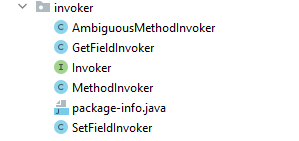Mybatis中的Invoker对反射API中的Field.get () Fielid.get() Method.invoke()三个方法进行了二次封装,将一些模板式的代码封装了起来,在新的版本中,还加入了安全检查。
其结构如下:

接口定义:
/*** @author Clinton Begin*/
public interface Invoker {Object invoke(Object target, Object[] args) throws IllegalAccessException, InvocationTargetException;Class<?> getType();
}
接口定义较为简单,我们来看看它的实现类,先看GetFieldInvoker:
/*** @author Clinton Begin* 对field的get(获取属性值)操作进行增强,增加了强吻(private修饰的属性通过设置setAccessible方法来强行操作)机制* 之所以不用getter方法可能是为了强吻,即不提供getter方法我也可以强制访问*/
public class GetFieldInvoker implements Invoker {private final Field field;public GetFieldInvoker(Field field) {this.field = field;}@Overridepublic Object invoke(Object target, Object[] args) throws IllegalAccessException {try {return field.get(target);} catch (IllegalAccessException e) {if (Reflector.canControlMemberAccessible()) {field.setAccessible(true);return field.get(target);} else {throw e;}}}@Overridepublic Class<?> getType() {return field.getType();}GetFiledInvoker,乍一看,还以为是操作getter方法,仔细观察发现它操作的是Field,而非 Method。一般我们自己操作Field时,遇到 private修饰的属性就需要强制访问了,GetFiledInvoker帮我们封装了这一步,而且,只有在发生IllegalAccessException 异常时才做强制访问(用private 修饰的field字段被反射操作时,会抛出此异常),这样做的好处是对于一些无需强制访问的Field,就不再需要开启强制访问,例如用public修饰的Field.
另外这里还会去检查权限的问题,如下代码:
Reflector.canControlMemberAccessible()就是说当你有权限的时候才能去开启强制访问,否则,你没有权限也去开启强制访问,自然也是失败的。
SetFieldInvoker和GetFieldInvoker代码几乎差不多,唯一区别是一个get,一个set,这里不再赘述。
MethodInvoker:
public class MethodInvoker implements Invoker {/*** 没有调用,还不清楚作用* */private final Class<?> type;private final Method method;/*** 参数长度是是1时,type=参数的类型* 否则,type=return type* */public MethodInvoker(Method method) {this.method = method;if (method.getParameterTypes().length == 1) {type = method.getParameterTypes()[0];} else {type = method.getReturnType();}}@Overridepublic Object invoke(Object target, Object[] args) throws IllegalAccessException, InvocationTargetException {try {return method.invoke(target, args);} catch (IllegalAccessException e) {if (Reflector.canControlMemberAccessible()) {method.setAccessible(true);return method.invoke(target, args);} else {throw e;}}}@Overridepublic Class<?> getType() {return type;}
}MethodInvoker 代码和GetFileldInvoker代码逻辑差不多,区别是MethodInvoker操作的是MethodInvoker的是Method对象,那么为什么会即提供了MethodInvoker又提供了GetFileldInvoker/SetFieldInvoker呢?我的猜测是当被操作的Bean有getter/setter时,mybatis会通过MethodInvoker来调用getter/setter完成属性的get/set,当被操作Bean的属性没有提供getter/setter时,这里就需要SetFieldInvoker和GetFieldInvoker来完成对field的get/set了,带着这个疑问我们去看一下Reflector源代码:

从setMethods/getMethods的泛型定义可以看出,这两个集合实际保存的是invoker,接着:

从266和275行可以得到两条信息:
1,setMethods/getMethods的key是field name
2,只有当setMethods中不存在该字段名对应的invoker时,才会添加,那么在什么情况下不存在呢?在该field没有getter/setter时。
也就是说,当setMethods|getMethods中没有field name对应methodInvoker时,才会调用 addSetField/addGetField,我们打开其中一个方法:

286行显示add了一个SetFieldInvoker并put到了setMethods中。
AmbiguousMethodInvoker:
public class AmbiguousMethodInvoker extends MethodInvoker {private final String exceptionMessage;public AmbiguousMethodInvoker(Method method, String exceptionMessage) {super(method);this.exceptionMessage = exceptionMessage;}@Overridepublic Object invoke(Object target, Object[] args) throws IllegalAccessException, InvocationTargetException {throw new ReflectionException(exceptionMessage);}Ambiguous是有歧义的意思,从字面意思上来猜测,它是一种提高健壮性的设计,当getter/setter的方法签名相同,返回类型却不同时,初始化不会停止,有歧义的getter/setter也不会被丢弃,如果你不调用,相安无事,当你调用的时候,立马抛出异常告诉你,这个方法可能由歧义。